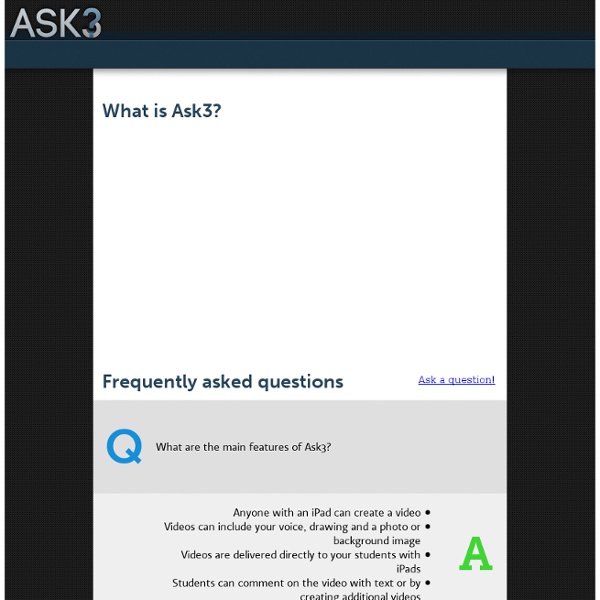



Beta Écrivez! Écoutez! On filme... Caroline Hétu et David Chartrand du Collège international Sainte-Anne De nos jours, la vidéo est un outil pédagogique très puissant. Type 1: Procast Ce type de vidéo éducative donne les meilleurs résulats, mais implique de nombreuses heures de travail pour la préparation du scénario, le tournage, l'infographie, le montage, la musique et les effets sonores. Logiciel recommandé: Camtasia Studio 7 (MAC et PC - license éducative 99$, version d'essai de 30 jours) Autres logiciel: Adobe Première Pro CS5.5 et Final Cut Pro X Pour faire du montage simple et gratuit, vous pouvez aussi utiliser Windows Movie Maker sur PC ou iMovie sur Mac. La vidéo suivante a pris près de 12 heures à produire. Type 2: LiveCast Ce type de vidéo éducative est produite simplement en utilisant une caméra standard ou une webcam. Logiciel recommandé (gratuit): YouTube La vidéo suivante a pris près de 7 minutes à produire, soit 5 minutes de préparation et 2 minutes de tournage. Type 4: PenCast
Annoter vidéo Flipped-Learning Toolkit: Let's Talk Tech Editor's Note:This post was co-authored by Aaron Sams, Managing Director of FlippedClass.com and founding member of the Flipped Learning Network. The greatest benefit of flipped learning is the restructuring of class time, which is more of a pedagogical solution than a technological solution. However, the in-class benefit is dependent upon the utilization of technology tools. So what technologies are necessary in a flipped classroom? Content Creation Tools One of the most difficult challenges for some teachers to overcome is the mastery of a content creation tool. Screencasting A popular software category for flipped learning is screencasting tools. Tablet Software Many teachers seek a tablet solution. Document Camera-Based Solutions Many teachers have document cameras in their rooms. Camera-Based Solutions Some teachers choose to forego software-based solutions and opt for the video camera. Record in a quiet room with a decent microphone. Distribution Tools These are only a few solutions.
EDPuzzle - Add Your Voice and Text Questions to Educational Videos EdPuzzle is a neat tool that I recently learned about from David Kapuler. EdPuzzle allows you to add your voice and questions to educational videos. On EdPuzzle you can search for educational videos from Khan Academy and Learn Zillion. Once you've found a video you can insert your own voice comments. You can also create a series of questions to go along with your chosen video. Applications for EducationEdPuzzle could be a good tool to use to create short review videos or flipped lessons for your students.
LearningApps.org - interaktive und multimediale Lernbausteine How to View That Forgotten Wireless Network Password in Windows Did you have someone else set up the wireless network in your house, and can’t for the life of you remember the password? If so read on to see how you may still be able to recover it. Note: Unfortunately this trick will only work if you are a local administrator on your machine, if you are not you will be prompted by UAC for administrative credentials. Viewing Your Wireless Password From an Already Connected Machine To view your wireless network password we need to get to the settings for your network adapter, so press the Win + R keyboard combination and type ncpa.cpl in the run box, then hit the enter key. You will now see all the network adapters in your machine, right-click on the wireless one and select Status from the context menu. When the Wi-Fi Status dialog loads up, click on the Wireless Properties button. Then you will need to switch over to the Security tab. Finally, check the Show characters checkbox to reveal your password. That’s all there is to it.
Créer un diaporama en associant images, sons et textes avec Raconte-moi Raconte-moi est un programme libre et gratuit qui permet d’importer des images puis d’enregistrer sa voix pour commenter chacune d’elles. Il est ensuite possible d’exporter le tout au format numérique et de disposer, par exemple, d’une histoire à écouter avec les images synchronisées défilant automatiquement à la manière du tourne-page. Les applications de ce programme peuvent être multiples et variées : raconter une histoire, créer un album photos, réaliser une présentation multimédia ou en définitive, toute autre application qui fera appel à l’image associée au son. Raconte-moi est particulièrement simple à prendre en main, il se présente autour d’une fenêtre principale qui va permettre de réaliser l’ensemble des actions. L’une des forces de cet outil tient à sa simplicité d’utilisation qui va permettre aux élèves de réaliser leurs propres productions. L’export vous fournira un dossier dans lequel vous trouverez le sous-dossier « export-html ». Vraiment très pratique! Caractéristiques
17 ways iPads will be used in schools in 2013 Last year, iPads in education took the world by storm, finding their ways into initiatives at both the K-12 and university levels. Here at Education Dive, we talked to some of the people responsible for those rollouts and watched as schools decided how to use tablets, whether they were Apple's or not. In 2013, iPads are still going strong. New pilot programs are winning over former doubters—and in some cases existing programs are expanding. So how will iPads be used as their classroom roles evolve in 2013? Education Dive found these examples: 1. 2. 3. 4. 5. 6. 7. 8. 9. 10. 11. 12. 13. 14. 15. 16. 17. Would you like to see more education news like this in your inbox on a daily basis?
eduCanon Science + Tic